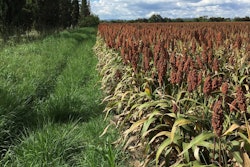
With U.S. farmers anticipating a record corn harvest, U.S. ethanol producers expecting record production of distiller’s dried grains with solubles (DDGS) and the global conversation about trade impacted by the U.S. elections, the timing could not have been better for Export Exchange 2016 in Detroit last October.
Unique event means big impact
Export Exchange is held every other year by the U.S. Grains Council (USGC) and the Renewable Fuels Association (RFA) to welcome global customers, offer them information on the current status of the U.S. grains industry and provide a unique opportunity for them to meet with U.S. suppliers and service providers across the corn, sorghum, barley and distiller’s dried grains with solubles (DDGS) value chains.
More than 200 international buyers and end-users of coarse grains and related products from 30-plus countries participated in the 2016 event, organized into 19 USGC trade teams who also took field tours in the U.S. Midwest. this massive undertaking pays off.
This massive undertaking paid off: a survey of customers attending as part of USGC trade teams showed an eye-popping $460 million worth of grains, equipment and other U.S. products sold around the time of the show or at the event itself.
Industry leaders provide market outlook for exports
In addition to networking opportunities, the conference featured an impressive list of speakers addressing important issues facing U.S. agricultural exports, offering customers and sellers in attendance an increased awareness of the benefits of U.S. coarse grains and co-products.
During the first general session of the conference, attendees heard about the state of agriculture exports. The U.S. is set to produce record crops of 384 million metric tons in 2016. Of that, it is anticipated that the U.S. will export 55 million metric tons of corn — another record.
“These numbers just go to demonstrate the productivity of our industry,” said Chip Councell, USGC chairman and a farmer in Maryland, who encouraged the grain users in the audience to invest in their infrastructure and capacity while prices are competitive.
Geoff Cooper, RFA senior vice president provided an outlook on U.S. ethanol industry co-product exports, with a focus on DDGS. Over the last 10 years, there has been dramatic growth in exports to Asian markets, particularly to China, though DDGS exports to there have been highly volatile since 2008. But exports to other regions are steady or expanding, including Mexico, Thailand, Turkey and several other countries.
Cooper said he expects we will see continued modest growth in U.S. distiller’s grains and corn gluten supplies as ethanol production continues to expand.
Christopher Nolan Sr., managing director and co-head of food, beverage and agribusiness coverage at PricewaterhouseCoopers Corporate Finance LLC, delivered the keynote address, highlighting the many opportunities for agribusiness in the global market.
Nolan stressed that evolving technology in agriculture will continue, and resourceful farmers will find ways to utilize technology to increase yield and reduce costs.
“Agribusiness is a global business and will continue to remain one,” he said.
Offering Education and News They Can Use
Export Exchange programming is focused on offering information buyers can use, whether they choose to meet with suppliers at the event or take back the new knowledge to their companies and local industries.
A panel of USGC consultants working with customers to maximize their use of grains every day offered an international perspective on DDGS utilization.
During the panel, Dr. Budi Tangendjaja, a consultant with USGC, described his work with a Vietnamese feed company that used formulation software but no DDGS database, showing the Export Exchange crowd the calculations he worked through with the customers. After helping the company include DDGS in its calculations, the feed mill realized cost savings.
Dr. Abdellah Ait Boulahsen, a Council consultant in Morocco, also outlined scenarios he has used with companies in that market, showing how they can use U.S. DDGS as part of a lowest-cost feed formulation.
U.S. DDGS are sold "consistently" to more than 40 countries with growth to other regions happening consistently, USGC Manager of Global Trade Alvaro Cordero, who rounded out the panel, told the crowd.
He stressed his experience with companies leaving money on the table by not taking advantage of U.S. DDGS, a common theme of conversations between buyers and sellers at the conference.
Later, attendees heard from Florentino Lopez, executive director of the United Sorghum Checkoff Program (USCP), regarding U.S. sorghum availability and new uses.
Generating interest in U.S. sorghum around the globe, including in places like the European Union and South Africa, is a priority for the USGC and USCP we work together to build steady, long-term and diversified demand for that coarse grain.
Trade Teams Reinforce Information About U.S. Supply Chain
The Detroit conference capped an experience for the 19 Council-sponsored trade teams visiting the U.S. Midwest before and after the main event, stopping at farms, ethanol plants, grain handling facilities and ports.
This was an opportunity for some of the U.S. grain chain’s top customers to see first hand this year’s record corn and sorghum harvests and U.S. export infrastructure in more than 15 U.S. states. Team visits began in mid-October and continued through early November.
These teams not only educate decision makers in export markets but also allow members of the U.S. industry to build personal relationships with their customers that can solidify long-term business and prompt new sales.
In a typical year, the Council will sponsor up to 40 trade teams, supported by checkoff organization and agribusiness members who help plan the events and host the teams while they are on the ground.
In an Export Exchange year, up to 20 of these teams happen at one time – a logistical feat, but one that is much appreciated by the customers for whom this is the highlight of the whole event.
This year, customers attending the Detroit conference also got a special opportunity to visit farms, ethanol plants and a layer facility in Michigan on pre-tours set up by USGC member Michigan Corn.
Championing Ag Trade – And Showing the Reliable U.S. Supply
Speakers, USGC and RFA leaders and even in attendance also emphasized to customers at the 2016 Export Exchange how important championing trade is, especially after a U.S. election cycle in which many criticized free trade agreements.
Grain exports are critical to farmer profitability in a time of lower prices and strong production. They can grow even further through outreach to the 95 percent of the world's consumers who live outside U.S. borders.
As newly-elected national leaders prepare to take office, Export Exchange 2016 was not only an excellent marketing opportunity for U.S. grains but a clear reminder to the industry and over global customers of our support for strong trade policies and robust overseas market development.
"Ag exports count for our farmer and agribusiness members and are counted on by customers who rely on the United States for a reliable supply of high-quality commodities and food products,” said USGC President and CEO Tom Sleight.
“Sales overseas are a bright spot in an otherwise tough ag economy and are something we can all work toward together.”
Editor’s note: more information about the event is at www.exportexchange.org or on social media at #ExEx16.


















